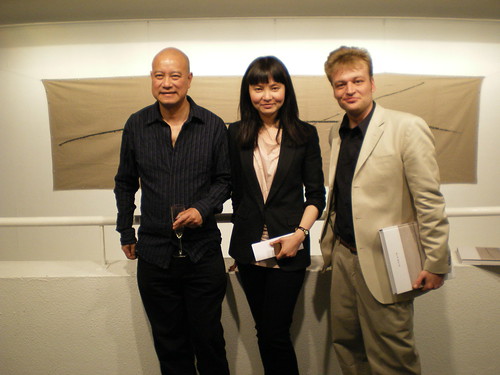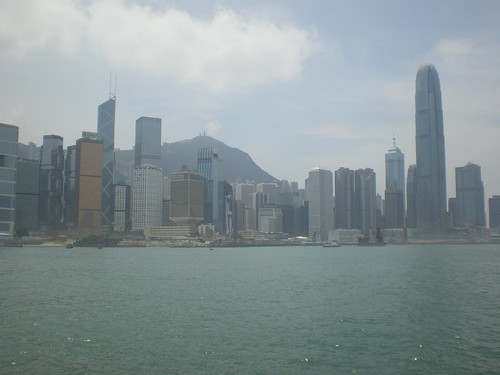
It’s a beautiful, kind of sunny spring day as the train rolls its way past the towering apartments of Kowloon on its way to Mainland China. I’ve been in Hong Kong for the past few days sipping free champagne, chomping on finger snacks and looking sideways at little blocks of color, thinking of profound-sounding things to say to impress pretty young women in cocktail dresses.
That’s right, it’s art season. Actually, it’s the feeding frenzy that leads up to the massive Sotheby’s spring auction, which this year is making one of its largest offerings of Chinese contemporary art ever. A long run of record-shattering auction prices for Chinese contemporary has attracted the players from every corner of the industry for a week-long session of art shows, banquets, name card exchanges and mass bar runs. I can’t claim innocence here; I came down specifically to join the cheering section for one of my favorite artists and clients, Ye Yongqing.
Commander Ye, as we call him, is an interesting case. He was extremely important in the conceptual and artistic movements of the eighties, collectively called the ’85 New Wave, and became even more so during the nineties as he travelled the nation and the globe not to promote himself but to promote the development and recognition of Chinese art, and to build links with other budding scenes especially in the Third World.
He was one of the first artists to enlist me in the field of art translation, and he has always been one of my staunchest supporters, nearly singlehandedly responsible for my reputation and client base (I can take at least a little credit in that department).
The funny thing is, I didn’t really become familiar with his art until about a year ago, and though his work is highly respected by fellow artists, he never really took off on the market or in the media until recently. There’s a very simple explanation for that – he’s just too damned busy. It’s surprising he’s had any time at all to develop his creative style what with his job as a professor at the Sichuan Academy of Fine Art, his founding of one of China’s first bona-fide art communities (Upriver Loft, Kunming) and his dozens of trips around the world to foster intercultural exchange. Yet his artistic style has followed an amazing trajectory, from his early days as a bit of an impressionist and dabbler in cubism, through his graffiti and archaeology inspired conceptual experiments of the nineties to his somewhat abstracted, highly meticulous and meditative works today, his artistic path has stretched farther than many artists half as busy as he.
His work now consists mostly of large birds or giant squiggles scrawled onto roughly treated canvases. From a distance they appear to be composed of broad, carefree strokes, but a closer look reveals that these are works of excruciating labor, made of thousands of tiny “chicken-scratch” strokes with a tiny brush.
The birds and squiggles resemble smaller ones that often featured in his earlier works. He often used birds and cages to play with ideas about freedom and confinement, and his own life is best described as migratory, which also helps explain the fascination. The squiggles are a bit less clear, but he’s always been playing with graffiti and scribble effects.
The term that pops to mind when trying to describe his recent works is “meditations”. To him, painting seems to have become a meditative exercise, and the resulting images the embodiment of the mental state he reaches. In this way, he shares as much in common with the traditional Chinese painters of old as he does with his peers in contemporary art.
But I’m not a critic, I’m a party crasher, and my skills in that department were put to great use this week. The main event was the most comprehensive Ye Yongqing retrospective ever held. It was organized by Anna Ning a young, up and coming dealer in Hong Kong, but it drew from many collectors and galleries to bring out pieces from almost every important stage in his development. Call me a cynic, but I have a feeling that this cooperative spirit was aided more than a little bit by the fact that a few of Ye’s works are going on the auction block this week.

Anyway, Anna did it up right, taking over a great space at the Hong Kong Art Center and putting a bunch of us up at the lavish Grand Hyatt right on the edge of the harbor, and coincidentally, a stone’s throw away from the Sotheby’s preview show.
So many people made the trip out that there were jokes about an evil cult assembly, mafia election or alien invasion. Whatever it was, once you get a few dozen darkly dressed Chinese guys in shaved heads together, you’re bound to attract some stares.

The opening was followed by a lavish five course meal for nearly 100 guests at the lovely Verandah Restaurant in Repulse Bay. We must have drained half their wine cellar that night. I had a chance to catch up with some of my favorite artists and meet some great people from the gallery, auction and critique fields. I decided to stay another couple of days to check out the Sotheby’s preview and crash the opening for Chen Jiagang’s exhibition.
Chen Jiagang is the current flavor of the month with a series of captivating photographs staged in the ruins of the Third Front, an area of China’s hinterland that Mao built up with military factories to shield them from an American nuclear strike. The massive buildup is now slowly returning to the soil, and the people who once ran it are now the forgotten heroes of China’s maniacal political history. His photos are lovely, but he’s become an overnight star and one must wonder if he’ll be able to live up to the hype in the future.
That was the inaugural show for Contemporary by Angela Li. Angela has been working in the field as a consultant for many years and is now going into full time business. She’s smart, personable and attractive, and I have every reason to believe she’s going to have a long and fruitful career. She definitely knows Chinese art like the back of her hand.
The after-party was held at the China club, on top of the old Bank of China building. Step through the doors and you’re in 1930’s Shanghai. They’ve done a beautiful job making the atmosphere there, and David Tang’s impressive art collection makes it just that much more special. But it was the view from the top floor balcony that stole the show. I tend to favor natural scenery, but I have to admit, Hong Kong is one of the most striking modern cities I’ve ever been to.
All in all, Hong Kong was a blast. In the past it was just a place for me to refill my China visa and load up on English books, magazines and cheap tailored suits. Now I’ve finally had a chance to see more of the city, and though I don’t think I’d want to live there, I’ll jump at the chance to go back.





